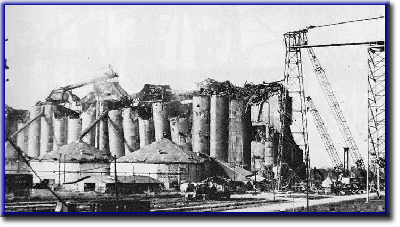
Shedding much needed light on Louisiana’s biggest tragedies is becoming somewhat of a specialty for Hahnville High School broadcast teacher Royd Anderson.
Anderson first burst onto the filmmaking scene with a documentary on the Luling Ferry Disaster, in which the George Prince ferry collided with a tanker in 1976. Overall, 78 people perished in the crash. The documentary was a thesis project for Anderson, who was then attending the University of Louisiana at Lafayette.
Now, Anderson is back with a new documentary, this one telling the relatively untold story of the 1977 Westwego Continental Grain elevator explosion, which caused 36 people to lose their lives and is still the deadliest grain dust explosion of the modern era.
The cause of the explosion is still unknown, though federal and state investigators at the time thought that the blast was caused by a buildup of grain because of a national dockworkers’ strike that year. Former Louisiana Agriculture Commissioner Gil Dozier told the UPI that “if you put any grain in an enclosure it’s like using the grain for mash and gasses are created. It’s not the grain that explodes, it’s the gasses that build up.” Dozier went on to say that spontaneous combustion could have then caused the catastrophe.
Now, many experts believe that a spark of ignition, either from machinery or static electricity, led to the explosion.
The blast destroyed 48 of the 73 giant silos used to store soybeans, wheat and oats at the plant. Most of the men that died were trapped in a two-story, cinder block office building that was crushed when a nearby 25-story grain elevator exploded.
Because of the tragedy in Westwego, three major safety regulations have been implemented to grain elevators nationally and abroad. Now, hundreds of heat sensors have been installed so that if a machine overheats, the workers will know right away. Pressure sensors also help reduce the thermal expansion of grain dust, and offices and control rooms have been moved to remote locations on plant sites.
The film will premier twice in St. Charles Parish, first on Jan. 10 at 7 p.m. at the West Regional Library in Luling, then on Jan. 11 at 10 a.m. at the East Regional Library in Destrehan.
The film lasts for 30 breathtaking minutes.
“The screenings have gone well,” Anderson said. “Viewers are grateful I’ve documented this sad, historic event.”
Anderson decided to follow up his first film with another disaster documentary after realizing that there wasn’t much information available on the Westwego grain explosion.
“There was a lot more data and information on the 1998 DeBruce Grain Elevator explosion in Kansas where only five people died,” Anderson said. “Louisiana often seems ignored in the national and global arena.”
Anderson said the Luling ferry disaster received similar attention, even though it was the deadliest ferryboat accident in U.S. history.
“Recently, I came across a British Columbia, Canada ferryboat blog online and they were discussing the 1976 Luling Ferry Disaster,” he said. “It was a totally new story to them in 2007.”
And while it was hard to get information for both documentaries, Anderson did find his second film somewhat easier because this time, he didn’t have to deal with the wrath of Mother Nature.
“Hurricane Katrina struck a couple of days after I began filming ‘The Luling Ferry Disaster,’” he said. “It was very difficult contacting folks due to the problems with communication at the time, and New Orleans was still off-limits for sometime.”
Because of the experience he picked up during his first film, Anderson was able to add more local and national news video footage in “The Continental Grain Elevator Explosion.” And while his second work may have more video footage, Anderson composed and recorded the music for both documentaries on his own.
Anderson hopes the footage, information and music of “The Continental Grain Elevator Explosion” will help spread knowledge about the disaster.
“I hope it documents and preserves local history,” Anderson said. “Also, it is important to obtain direct information from survivors of the accident, immediate family of survivors, rescuers and law enforcement agents that are still alive, but may not be if we wait any longer.”




Be the first to comment